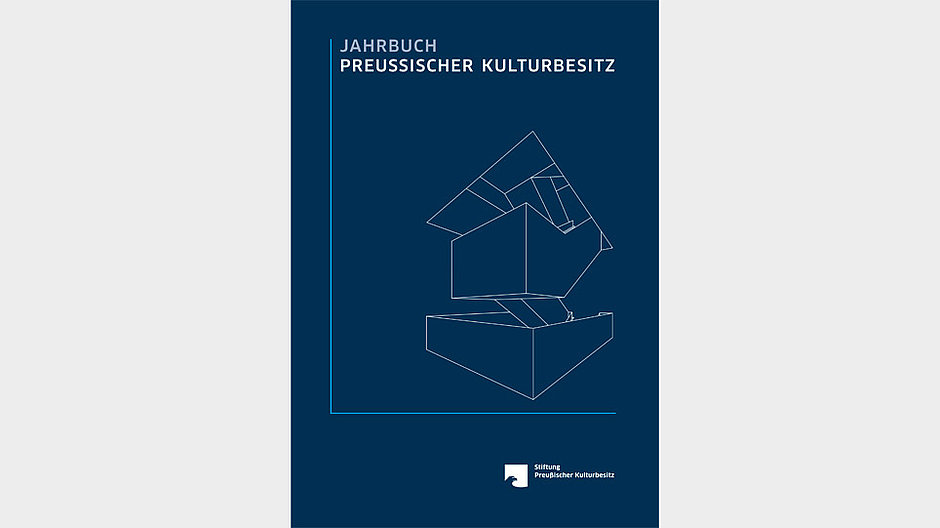Bereichsnavigation
Jahrbuch Preussischer Kulturbesitz, Vol. 51 / 2015
Among the topics covered in the 51st issue are the challenges posed to museums by the current debate on immigration and closed borders, the Foundation's contribution to protecting cultural heritage, and the way ahead for the German-Russian Museum dialogue. On a lighter note, you can also find out why a high-speed train would sound louder in red than in green, that even Goethe possessed a price list from the Gipsformerei (Replica Workshop), and what connects northern Chile with electric cars in Berlin.
Blurb:
The cover appears to show an avant-garde sculpture, but in is fact the staircase of the Archäologisches Zentrum (Archaeological Centre) of the Staatliche Museen zu Berlin (National Museums in Berlin), not far from Museumsinsel (Museum Island). This is the architectural centerpiece of one of the SPK's driving forces in 2015. The Archäologisches Zentrum was the seedbed for many projects that have since set out important road maps for the work of the Foundation. They are the subject of several articles in the yearbook. In one of them, Markus Hilgert looks at how the role of archaeological museums is changing in the 21st century, as their focus continues to shift from acquiring objects to protecting them, thus making cooperation with the countries of origin essential. We learn what that can look like in practice from Friederike Seyfried and Robert Kuhn, writing about safeguarding and exploring the tombs of the northern part of the Qubbet el-Hawa hill in Egypt. Ursula Hartwieg explains the need to coordinate cultural heritage protection, in particular that of written cultural property, and the role that politicians and institutions need to play in this.
2015 was also the year in which the Zentralarchiv (Central Archive), based at the Archäologisches Zentrum, completed one of the largest provenance research projects ever undertaken by the Staatliche Museen zu Berlin. This concerned the origin and ownership history of over five hundred works from the collection of the Galerie des 20. Jahrhunderts (Gallery of the 20th Century), which the Berlin Senate had acquired between 1945 and 1968 in order to fill the gaps in the Berlin collection created by the National Socialists' purge of so-called "degenerate art". Christina Thomson and Bernhard Maaz describe how the works passed through many different hands before they were purchased and the insights this gave into the collection of early modernism at the Neue Nationalgalerie, as well as how modernism rose again from the ashes of Berlin after the war.
The Archäologisches Zentrum also houses the administrative headquarters of the Museum für Islamische Kunst (Museum of Islamic Art). In his article, the latter’s director, Stefan Weber, offers answers to the question of what museums can contribute to the debate over Islam. Nanette Snoep adds the story of how the Staatliche Ethnographische Sammlungen Sachsen (National Ethnographic Collections of Saxony) sent a signal in opposition to the Pegida movement.
A road map also had to be laid out in 2015 for completing the Humboldt Forum: the SPK President, Hermann Parzinger, discusses why the concept of "shared heritage", meaning cultural heritage, is so important to the work of museums, especially at the Humboldt Forum. There are also several reports on the perspektiven15 conference, which focused on the long-term digital future of the Humboldt Forum.
In a similar vein, the 2015 yearbook looks at cooperation with Russian museums: on the tenth anniversary of the German-Russian Museum Dialogue, Manfred Nawroth takes stock of its progress, while Julien Chapuis, Neville Rowley, and Vasily Rastorguev offer glimpses from different perspectives into a joint research project on sculptures by Donatello that were taken from Berlin's museums to Moscow's Pushkin Museum after the Second World War.
Also in this issue: Eugen Blume offers impressions of an exhibition centered on Joseph Beuys' piece Das Kapital, Ingeborg Harms examines the interface between fashion and art, and Jörg Magenau describes how – by purchasing the archives of two publishing houses, Aufbau and Wagenbach – the Staatsbibliothek zu Berlin (Berlin State Library) came into the possession of parallel chapters of East and West German history and great literature all at the same time.
Hans-Joachim Maempel introduces the virtual concert hall at the Staatliches Institut für Musikforschung (State Institute for Music Research), Sven Felix Kellerhoff tracks the relocations of archives during the Second World War, Martin Hollender revisits a lawsuit brought by the federal states against Federal President Heuss, and Barbara Göbel of the Ibero-Amerikanisches Institut (Ibero-American Institute) investigates the social consequences of mining lithium in the Atacama Desert. And finally, Eberhard Diepgen, a former Governing Mayor of Berlin, pays tribute to Wolf-Dieter Dube, a long-serving, almost legendary director of the Staatliche Museen zu Berlin, who died in 2015.


